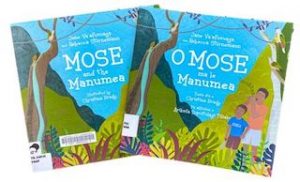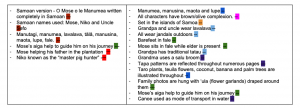Over the course of what would normally be my university summer break, I was granted the opportunity to conduct valuable research specifically around Pasifika picturebooks. Both Te Whāriki (Ministry of Education [MoE], 2017) and Tapasā: Cultural competencies framework for teachers of Pacific learners (MoE, 2018) recognise the importance of immersing children in environments that reflect and affirm their culture, beliefs, knowledge, and values, in order to foster their success and well-being. Therefore, the curriculum and education that Pasifika children experience should reflect who they are as members of their communities, and identity, language, and culture should guide teacher pedagogy and practice. The aim of this project was to deepen our learning about Pasifika identities and values enabling teachers to “better understand and respond to Pacific learners using picturebooks as pedagogical tools in diverse classrooms” (Daly & McKoy, 2013).
During my research I located a total of 91 picturebooks reflecting a wide range of Pasifika nations, cultures, and languages. Most of these picturebooks were only found and accessed through the National Library online database and interloan service. Once I received these books I read and analysed them according to the cultural content within each book inclusive of both text and illustrations. One of the main focuses of the project was to identify picturebooks that were authentic and written by ‘insiders’, or at least involved input from Pasifika individuals and communities with authentic cultural knowledge and understanding.
I have shared one book below, but to access the full list of Pasifika picturebooks please refer to the annotated bibliography.
Mose and the Manumea (Va’afusuaga & Stirnemann, 2018) was sourced from my local library here in Tauranga Moana. Its Samoan counterpart O Mose ma le Manumea (Va’afusuaga & Stirnemann, 2018) was only retrievable from the National Library of New Zealand in Auckland. This Little Island Press publication has been carefully curated by both Jane Va’afusuaga and Rebecca Stirnemann. Though neither of the authors are of Pacific Island descent, both have valuable first-hand knowledge and experience of Samoan ways of living, being and doing. Va’afusuaga draws on four years of teaching experience in Apia, Samoa and her life in the village of Falease’ela where she lives with her Samoan husband and children. Full immersion in village life has helped Jane to gain genuine insights into the language, culture, church, and customs of Samoan people. Stirnemann has also experienced living in Samoa for seven years as an ecologist dedicating her time and efforts to protecting native birds of Samoa including the endangered Manumea (tooth-billed pigeon).
Initially in the picturebook, we get a glimpse into a fale where the walls are decorated with family photos and ‘ula (garlands). Grandma sweeps the floor with a salu broom while Mose and his Grandpa sit on a woven pandanus mat discussing the endangered Manumea. We follow Mose and his aiga (family) on their hunt for the Manumea as they navigate the tropical Samoan landscape and its abundance of teuila (the state flower of Samoa), taro plants, coconut and banana trees, native wildlife, glorious white sand beaches, and dense forests.

This picturebook touches on topics including conservation and Samoan culture, living and language, all the while exploring Pasifika values from a broader perspective.
The native tooth-billed pigeon of Samoa is scientifically known as the Didunculus strigirostris and is one of the closest living relatives of the extinct dodo. Found exclusively in the islands of Samoa, this native bird is in dire need of protection for if the Manumea becomes extinct, sadly the species will be lost forever. The Manumea is not only a fundamental part of Samoan culture, history and heritage but it also plays a crucial ecological role ensuring that fruits are distributed to promote the growth of native trees. In 1997, it was estimated that around 4000 of these birds existed but unfortunately those statistics have dwindled. More recent predictions indicate that there may only be between 150 to 200 Manumea remaining.
Throughout this picturebook, the scarcity of the Manumea and its endangered status is regularly mentioned with Mose acknowledging how great it would be if he could help to save the birds. Toward the end of the book you will find an informative section that offers further information about the bird and ways in which people can contribute to the protection of these beautiful animals.

Pasifika picturebooks play a critical role in education to ensure that the strengths, interests, needs, identities, languages and cultures of Pasifika children are reflected within their environment. Using picturebooks as pedagogical tools better informs teachers so they can become more culturally competent and inclusive in relation to Pasifika learners and expand the range of connections to language, culture, and identity for Pasifika children and their families in educational contexts (Te Whāriki, MoE, 2017).
Cushla Foe
Summer Research Scholar (2020–2021)
